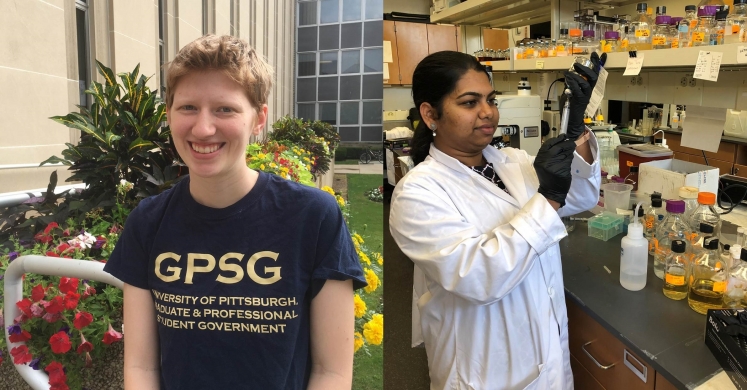Blog

Meet a Scientist: Narthana Jeganathar Kanmanii and Mariah Denhart
All of the researchers featured on Phipps' Meet a Scientist Saturdays have been trained through our science communication workshops. If you are graduate student, faculty, or professional in any field of STEM and you are interested in the workshop or participating in a Meet a Scientist Saturday, check out our website or contact Phipps’ Science Education Outreach Manager Dr. Maria Wheeler-Dubas at mwheeler-dubas@phipps.conservatory.org.
This weekend, come meet two local scientists and learn about the making the world a better place through a deeper understanding of developmental genetics and remediation of contaminated soils! Doctoral students Narthana Jeganathar Kanmanii, Duquesne University, and Mariah Denhart, University of Pittsburgh, will be in the Tropical Forest this Saturday, March 16, from 1:30-3:30 p.m. Come chat with them!
Welcome! Introduce yourself in five sentences or less:
Narthana: I’m Narthana Jeganathar Kanmanii, 4th year biology Ph.D. student at Duquesne University. I’m an environmental microbiologist and my interest is to study microbes and their role in bioremediation. To be specific, I do research on how anaerobes could help in clean up the toxic heavy metals in the environment based on their metabolic requirements. Outside of research, I enjoy gardening and read books.
Mariah: I am currently investigating how a family of proteins known as T-box proteins control normal limb development. These proteins are known as transcription factors which are a type of protein that can control when genes are turned on or off. All T-box proteins recognize the same sequence of DNA, but each can have different effects on a gene: some of these proteins only turn genes off, some only turn them on, and some are able to do either depending on the tissue. The developing limb simultaneously expresses several major T-box proteins, and when they are not expressed at the correct levels human diseases such as Holt-Oram and Ulnar-Mammary syndrome can arise. We hypothesize that competition between multiple T-box proteins is necessary for normal limb development.
Why did you become a scientist?
Narthana: During my childhood, I had observed the effects and impacts of water pollution to the environment. This experience in childhood was the motivation to become a scientist so that I can help create an eco-friendly and a cleaner society.
Mariah: As a kid, I loved learning about animals and spent a lot of time taking extra science classes or going to interactive science museums. However, the first time I realized I wanted to pursue a scientific career was when I started college and joined a research team investigating marine sponges and the bacteria that live inside them as a way to monitor the health of marine environments. After I graduated I decided I wanted to continue to develop my skills as a scientist and am now a graduate student at the University of Pittsburgh.
What Do you Like to do Outside the Lab?
Mariah: When I am not working on science I usually spend my free time trying to relax by either drawing or spending time walking my dog, Buckles.
What is the most exciting thing you’ve ever done at work?
Narthana: I’m fascinated to know how certain microbes utilize heavy metals for their living rather than using oxygen. The most exciting part of my research is to explore how active proteins from the bacteria can convert toxic metal to nontoxic form through different assays.
What is your favorite part of your job?
Mariah: One of my favorite parts of my job is having the opportunity to talk about my research with others because they often ask questions I have not thought of before or suggest new ideas or experiments to design. Science outreach is important for encouraging people to question the world around them and for scientists to explain how they are tackling different problems. Science is a benefit for all, and therefore communication between non-scientists and scientists is key to moving forward and finding new ideas or problems to explore. In addition, science outreach can hopefully inspire new people to become scientists who will bring new ideas and skills to the field.
What skills do you use in your job?
Narthana: Researching and problem-solving are the two important skills that I use day-in and day-out. I use analysis skill to assess large amount of data and to take decision. Furthermore, some of the other skills that I use during research are communication, teamwork and leadership.
What Does a Day in the Lab Look Like For You?
Mariah: Typically, my day in the lab starts with deciding what smaller questions I want to try to answer that will help me answer my big question. After I have decided on the question I set out on designing and performing the experiment. One of the most exciting things that happens in lab is when an experiment actually works as expected. More often than not, experiments do not always work on the first try, and I have to redesign the experiment or read more papers on the subject to find out what I might have missed the first time.
If you weren’t a scientist, what would you be?
Narthana: I have a great passion for dance. So, if I weren’t a scientist, I would be a dance choreographer.
Why is science education important?
Narthana: Everyone’s life revolves around science. To better understand how humans have been evolved from a tiny particle in this earth, it is necessary to understand how science works. Science involves curiosity, new findings, explorations and excitement.

